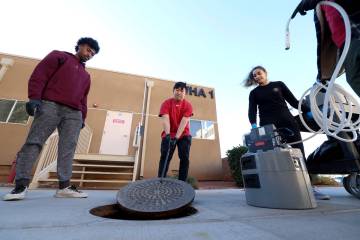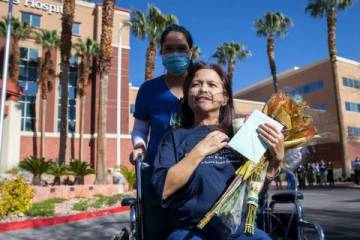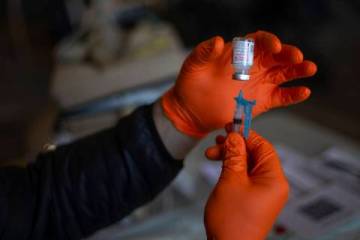Clark County’s homeless deaths go up; coronavirus not to blame
Clark County’s homeless communities have largely been spared by the coronavirus. Few have died, and officials say the positivity rate is on par with the general public’s.
Yet the number of deaths on the street has increased by about 16 percent compared with last year, according to data provided by the coroner’s office.
“Anytime you see a spike in deaths in a vulnerable population, obviously there’s going to be a lot of concern,” UNLV epidemiologist Brian Labus said.
In response to the pandemic, the county has spent millions in federal dollars to increase housing and rental assistance. But despite the efforts, 186 homeless people died in Clark County from Jan. 1 to Dec. 4.
That’s about 35 deaths per 1,000 homeless people, six more than last year, when there were more people in shelters and on the streets.
Experts say the trend reflects that homeless populations are getting older and sicker, drug use is soaring, and the pandemic has made it more difficult for unhoused people to access health care and other services. And, more people are on the streets.
“In general, the COVID-19 pandemic identified a lot of gaps and a lot of issues with health, and our health care system in general,” said JoAnn Rupiper, the Southern Nevada Health District’s director of clinical services. “Especially when it relates to an underserved and vulnerable population. It just magnified it.”
‘We’re living in a different world’
The Centers for Disease Control and Prevention has said that 299,028 excess deaths occurred from late January through Oct. 3, with 66 percent of excess deaths attributed to COVID-19. 
For outreach workers like Thomas “Chicago” Randle-El, each death on the street is preventable and a reminder of what is at stake when local officials draft policies addressing the estimated 5,283 people who are homeless in Clark County on any given night.
“We’re living in a different world now,” said Randle-El, who holds an annual memorial for the homeless. “This is just some more stuff to pile onto the homeless, and the new homeless that are in housing and getting ready to be evicted.”
The pandemic also has disrupted normal health services and made it harder for those who were unhoused and without access to access virtual appointments.
For a population whose bodies are breaking down at a faster rate as a result of being out in the elements, it’s especially devastating — and especially those already living with chronic conditions like heart issues or diabetes.
“COVID has certainly strained our health care infrastructure so that there were even more barriers for this population,” Rupiper said. “In general, all the populations have not been accessing health care as they probably could have. That is multiplied when you’re homeless.”
As a result, Rupiper’s team at the health department has visited encampments and shelters to administer 2,451 COVID-19 tests and 409 flu vaccines this year.
Many advocates say that housing in itself is a form of health care, and Clark County has said that is a priority.
More than 1,000 beds have been set up for the more medically fragile homeless people in hotels or other temporary housing to protect them from COVID-19 exposure.
A snapshot of life on the streets
And though people are still dying, such programs are what make a significant impact on public health, according to Eric Tars, legal director of the National Law Center on Homelessness & Poverty.
During a housing conference this month, Tim Burch, Clark County administrator of human services, said the county has estimated that 120,000 households are behind on rent because of COVID-19. Through federal funds, the county has invested $100 million in rental assistance and more than $50 million in more affordable housing.
“These are some of the things that we were looking for utilizing lessons learned during the pandemic to do things post-pandemic,” Burch said.
This year’s deaths provide a snapshot of life on the streets. Some died from the elements; others had health conditions that went untreated. Fifty-seven died from substance abuse and 11 by homicide. The youngest was 18 and the oldest was 88.
On May 5, Richard Turner was found May 5, stabbed in the neck inside the drainage tunnel on Flamingo Road. He was 44. Linda Swann, 62, died from heat exposure and heart disease. On a sidewalk, 52-year-old Theodore Simmons died from cardiovascular disease and liver cirrhosis.
“A virus that creates a pandemic is invisible, however an avalanche of evictions and people becoming homeless is not invisible,” said Donald Whitehead, executive director of the National Coalition for the Homeless. “It just boggles the mind that we weren’t prepared for it.”
Contact Briana Erickson at berickson@reviewjournal.com or 702-387-5244. Follow @ByBrianaE on Twitter.






































